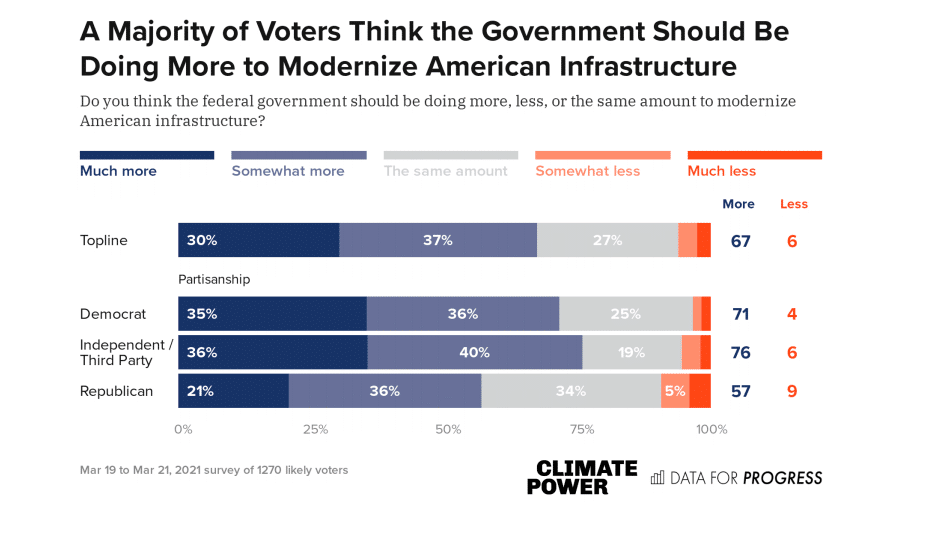This blog was written by Jennifer Rennicks, former Senior Director of Policy & Communications at the Southern Alliance for Clean Energy.
Guest Blog | March 31, 2021 | Climate Change, Electric Vehicles, Energy Policy, Solar, WindBack in the 1990s, the ‘Jobs vs Owls’ debate raged: proponents and opponents argued that we had to choose between protecting an endangered species or protecting workers. That ‘economy vs. environment’ debate was framed as a zero-sum game with one possible winner and one clear loser. The multitrillion-dollar infrastructure and jobs plan that President Biden announced today is proof that with the right policies and incentives we can succeed in addressing the threats of climate change while creating millions of well-paying union jobs, rebuilding the country’s infrastructure, and fueling our much-needed economic recovery.

Clean energy solutions to address the climate crisis
The American Jobs Plan calls for big investments on the scale of the 1950s and 1960s when the nation built the interstate highways and won the Space Race.
There is plenty in this sweeping jobs, infrastructure, and transit plan that clean energy and climate advocates will like, particularly the proposals to transform our energy sector by ending fossil fuel subsidies, and there is also room for improvement. While this new proposal is vastly larger than the roughly $100 billion marked for clean energy in the 2009 stimulus package, this proposal could and should be viewed as a starting point with opportunities for bigger, bolder investments passed by Congress in order to adequately confront the climate crisis, tackle historic unemployment levels, and address underinvestment in disproportionately-impacted, frontline communities. Biden also recently announced the members of an Environmental Justice Advisory Council which will be tasked with offering input on how to address issues of environmental injustice.
While the larger infrastructure package includes a wide array of proposed investments from airports and bridges to water systems and hospitals, we can already see some details specific to unprecedented clean-energy investments including:
- Creating new jobs electrifying vehicles, with a $174 billion investment to gain the edge in a globally competitive EV market by growing the supply chain, expanding manufacturing, building a national network of 500,000 EV chargers, and replacing or electrifying transit and fleet vehicles
- Mitigating the cumulative impacts of air pollution on neighborhoods near ports and transportation corridors, often disproportionately impacting communities of color
- Making our infrastructure more resilient in the face of increasingly severe floods, wildfires, hurricanes, and other impacts of climate change
- Investing $100 billion over eight years to modernize the electricity sector, resulting in a 100% carbon-free grid by 2035, a more resilient electric transmission system, and lower energy bills
- Building, preserving, and retrofitting millions of homes and commercial buildings to ensure affordable, resilient, accessible, energy efficient, and electrified units are available
- Approving a ten-year extension and direct-pay of tax credits for clean energy generation and storage
- Establishing the United States as a leader in climate science, innovation, and R&D
- Jumpstarting clean energy manufacturing through federal procurement
It is probable that these federal investments, modest though they may sound relative to the scope of the climate crisis, will send the right market signals and encourage private investment and unlock even more funds for the much-needed clean-energy transformation.
The scale and scope of these proposed investments appear to have voters’ backing: recent polling indicates 67% of Americans say the federal government should be doing more to modernize American infrastructure and a poll of leading economists suggest they agree. In the days before this announcement, S&P Global predicted that “Biden’s infrastructure plan will create 2.3 million jobs by 2024, inject $5.7 trillion into the economy — which would be 10 times what was lost during the recession — and raise per-capita income by $2,400.”

All of these investments and actions will play a role in fulfilling one of President Biden’s campaign goals to achieve 100% clean power by 2035. A vital policy discussed in the sweeping jobs & infrastructure plan which can help the utility sector decarbonize is an Energy Efficiency & Clean Electricity Standard (EECES). Earlier this year, Evergreen Action published a report showing how the proven and popular 100% Clean Electricity Standard, along with complementary policies and incentives, could accelerate the transition of the electricity sector, creating jobs while saving consumers money on their electric bills.
A key component of President Biden’s clean energy plan will be to unlock the vast the clean energy resource of offshore wind, and earlier this week the White House signaled it intended to do just that. The Administration said it would be opening up new tracts for leasing and investing in port upgrades to spur the construction of up to 30 gigawatts of capacity along U.S. coasts by 2030. And, unlike today’s legislative proposal, these actions can be done entirely through the Executive Branch without Congressional approval. Given the substantial offshore wind energy potential along our Southeastern coasts, these actions bode well for our region, so we will be watching closely to see if North Carolina, South Carolina, and Georgia can benefit from these investments and action. We’ll be blogging in greater detailed about this announcement in particular soon, so check back here in the coming days.
Will TVA become a national leader once again?
In addition to embracing an offshore wind-powered electricity grid, another way the Southeast may play a unique role in the clean energy transformation could be through the Tennessee Valley Authority (TVA). Founded as a 100% renewable energy-powered utility in the 1930s as part of the New Deal, TVA’s original mission included promoting environmental stewardship, job creation, and innovation to provide power to the residents and industries in the Tennessee Valley.
“As the nation’s largest public power utility, and as an extension of the Administration, TVA should lead by example by demonstrating the path to zero carbon. The infrastructure bill is the right mechanism and applying a clean energy standard is the right methodology to meet these goals,” Dr. Stephen A. Smith, Executive Director of the Southern Alliance for Clean Energy.
Yesterday, SACE issued a statement and held a press conference calling upon TVA to once again lead the utility industry by converting entirely to carbon-free electricity generation within the next decade as a central part of President Biden’s plan to fight the threats of climate change through clean energy investments.
“TVA led the nation at its founding as an innovative clean-energy powered utility, and is well-positioned to do so again with a portfolio that already includes significant non-carbon resources, including hydroelectric capacity and a large hydro pumped storage facility, which are national assets. The electric sector is not going to become carbon-free through market forces alone,” Maggie Shober, Director of Utility Reform of the Southern Alliance for Clean Energy.
Can the U.S. recover its role as a world leader on climate action?
The infrastructure plan and other related policy proposals are concrete steps to bolster the climate and energy-related Executive Orders signed in Biden’s first days in office. In addition, last week the Biden Administration announced it had invited 40 world leaders to a virtual Leaders Summit on Climate (a full list of invited leaders and stated goals for the summit can be found here) to help “galvanize efforts by the major economies to tackle the climate crisis.”
The summit itself is a key milestone before the next United Nations Climate Change Conference (COP26) in November in Glasgow, but the fact that Washington is hosting is a critical factor in demonstrating that the United States is serious about reclaiming a global leadership role in climate action on the world stage after years of climate denial and international isolationism culminating with the withdrawal of the US from the Paris Climate Agreement in late 2019.
There is plenty to digest from just the last week’s worth of climate and clean energy-centered announcements, invitations, and proposals, and there is always room for improvement at both the federal and state levels, but early signs point to a sea change in the ways and tools the United States is using to confront the climate crisis. We look forward to continued actions from the federal government to help lead the clean energy transformation we so desperately need.
